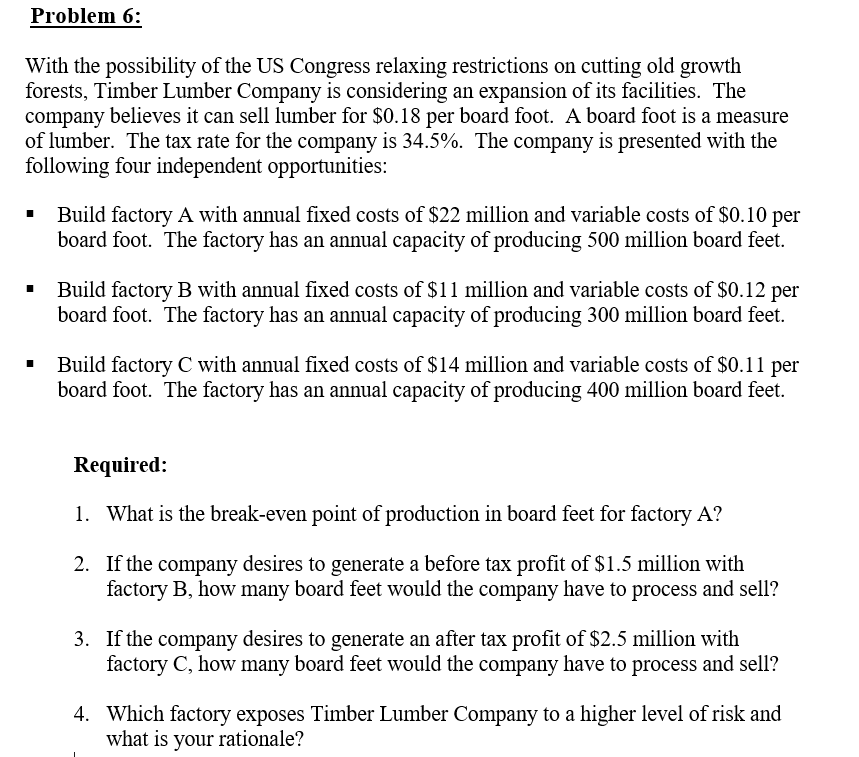With the possibility of the US Congress relaxing restrictions on cutting old growth forests, Timber Lumber Company is considering an expansion of its facilities. The company believes it can sell lumber for $0.18 per board foot. A board foot is a measure of lumber. The tax rate for the company is 34.5%. The company is presented with the following four independent opportunities: Build factory A with annual fixed costs of $22 million and variable costs of $0.10 per board foot. The factory has an annual capacity of producing 500 million board feet. Build factory B with annual fixed costs of $11 million and variable costs of $0.12 per board foot. The factory has an annual capacity of producing 300 million board feet. Build factory C with annual fixed costs of $14 million and variable costs of $0.11 per board foot. The factory has an annual capacity of producing 400 million board feet. Required: 1. What is the break-even point of production in board feet for factory A? 2. If the company desires to generate a before tax profit of $1.5 million with factory B, how many board feet would the company have to process and sell? 3. If the company desires to generate an after tax profit of $2.5 million with factory C, how many board feet would the company have to process and sell?
With the possibility of the US Congress relaxing restrictions on cutting old growth forests, Timber Lumber Company is considering an expansion of its facilities. The company believes it can sell lumber for $0.18 per board foot. A board foot is a measure of lumber. The tax rate for the company is 34.5%. The company is presented with the following four independent opportunities: Build factory A with annual fixed costs of $22 million and variable costs of $0.10 per board foot. The factory has an annual capacity of producing 500 million board feet. Build factory B with annual fixed costs of $11 million and variable costs of $0.12 per board foot. The factory has an annual capacity of producing 300 million board feet. Build factory C with annual fixed costs of $14 million and variable costs of $0.11 per board foot. The factory has an annual capacity of producing 400 million board feet. Required: 1. What is the break-even point of production in board feet for factory A? 2. If the company desires to generate a before tax profit of $1.5 million with factory B, how many board feet would the company have to process and sell? 3. If the company desires to generate an after tax profit of $2.5 million with factory C, how many board feet would the company have to process and sell?
Chapter10: Short-term Decision Making
Section: Chapter Questions
Problem 4EB: Dimitri Designs has capacity to produce 30,000 desk chairs per year and is currently selling all...
Related questions
Question
See attached.

Transcribed Image Text:With the possibility of the US Congress relaxing restrictions on cutting old growth
forests, Timber Lumber Company is considering an expansion of its facilities. The
company believes it can sell lumber for $0.18 per board foot. A board foot is a measure
of lumber. The tax rate for the company is 34.5%. The company is presented with the
following four independent opportunities:
Build factory A with annual fixed costs of $22 million and variable costs of $0.10 per
board foot. The factory has an annual capacity of producing 500 million board feet.
Build factory B with annual fixed costs of $11 million and variable costs of $0.12 per
board foot. The factory has an annual capacity of producing 300 million board feet.
Build factory C with annual fixed costs of $14 million and variable costs of $0.11 per
board foot. The factory has an annual capacity of producing 400 million board feet.
Required:
1. What is the break-even point of production in board feet for factory A?
2. If the company desires to generate a before tax profit of $1.5 million with
factory B, how many board feet would the company have to process and sell?
3. If the company desires to generate an after tax profit of $2.5 million with
factory C, how many board feet would the company have to process and sell?
Expert Solution
This question has been solved!
Explore an expertly crafted, step-by-step solution for a thorough understanding of key concepts.
This is a popular solution!
Trending now
This is a popular solution!
Step by step
Solved in 4 steps with 3 images

Knowledge Booster
Learn more about
Need a deep-dive on the concept behind this application? Look no further. Learn more about this topic, accounting and related others by exploring similar questions and additional content below.Recommended textbooks for you

Principles of Accounting Volume 2
Accounting
ISBN:
9781947172609
Author:
OpenStax
Publisher:
OpenStax College

Intermediate Financial Management (MindTap Course…
Finance
ISBN:
9781337395083
Author:
Eugene F. Brigham, Phillip R. Daves
Publisher:
Cengage Learning

EBK CONTEMPORARY FINANCIAL MANAGEMENT
Finance
ISBN:
9781337514835
Author:
MOYER
Publisher:
CENGAGE LEARNING - CONSIGNMENT

Principles of Accounting Volume 2
Accounting
ISBN:
9781947172609
Author:
OpenStax
Publisher:
OpenStax College

Intermediate Financial Management (MindTap Course…
Finance
ISBN:
9781337395083
Author:
Eugene F. Brigham, Phillip R. Daves
Publisher:
Cengage Learning

EBK CONTEMPORARY FINANCIAL MANAGEMENT
Finance
ISBN:
9781337514835
Author:
MOYER
Publisher:
CENGAGE LEARNING - CONSIGNMENT

Principles of Cost Accounting
Accounting
ISBN:
9781305087408
Author:
Edward J. Vanderbeck, Maria R. Mitchell
Publisher:
Cengage Learning


Managerial Accounting: The Cornerstone of Busines…
Accounting
ISBN:
9781337115773
Author:
Maryanne M. Mowen, Don R. Hansen, Dan L. Heitger
Publisher:
Cengage Learning